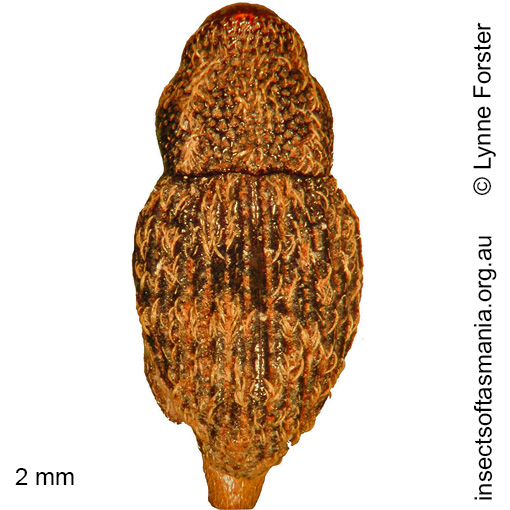
Decilaus striatus (a species of weevil)
Basis for Tasmanian occurrence
TMAG collections
Classification
Order: Coleoptera
Suborder: Polyphaga
Superfamily: Curculionoidea
Family: Curculionidae
Subfamily: Molytinae
Tribe: Cryptorhynchini
Morphology
Typical length (mm): 2
Flightedness: (not yet documented)
Morphology (characterised by L. Forster): — Elytra deeply striated, interstices wider than striae with with large punctures and sparse, long, semi-decumbent, straw-coloured scales — Pronotum with large punctures and sparse, long, semi-decumbent, straw-coloured scales in three feeble lateral lines from base.
Source literature on morphology and taxonomy (*primary taxonomic source, where identified):
*Lea, A.M. (1913). Descriptions of Australian Curculionidae, with notes on previously described species. Part X1. Trans. Roy. Soc. S. Aust. 37: 301-445. [Pages 384-5].
Ecology
Assumed larval feeding: wood-feeder
Association with dead wood or old trees: obligately saproxylic
Ecological attributes: — Affiliated with interior of mature (unlogged) forest (Baker et al., 2007a) — Affliliated with mature (unlogged) forest (Baker et al., 2009c) — Affliliated with mature (unlogged) forest (Baker, 2006a) — Found under large logs (Grove et al., 2006) — May occupy logs or trunks of Eucalyptus obliqua, at least temporarily, since found having emerged within a year of felling (Grove & Bashford, 2003) — May occupy logs or trunks of Eucalyptus obliqua, at least temporarily, since found having emerged within six years of felling (Grove et al., 2009).
Collection method(s) for TMAG material: — Emergence trapping from log of Eucalyptus obliqua — Extraction by Berlese funnel from leaf litter — Flight intercept trapping (trough below Malaise trap) — Hand collection from under log of Eucalyptus sp. — Malaise trapping — Pitfall trapping.
Source ecological literature:
Grove, S.J. & Bashford, R. (2003). Beetle assemblages from the Warra log decay project: insights from the first year of sampling. Tasforests 14: 117-129.
Grove, S.J. (2009b). Beetles and fuelwood harvesting: a retrospective study from Tasmania’s southern forests. Tasforests 18: 77-99.
Grove, S.J. et al. (2006). What lives under large logs in Tasmanian eucalypt forest? Tas. Nat. 128: 86-93.
Baker, S.C. (2000). Forest litter beetles and their habitat: a comparison of forest regenerated by wildfire and logging practices. Hons. thesis, Univ. of Tasmania, Hobart.
Baker, S.C. (2006b). Ecology and conservation of ground-dwelling beetles in managed wet eucalypt forest: edge and riparian effects. PhD thesis, Univ. of Tasmania, Hobart.
Grove, S. et al. (2009). A long-term experimental study of saproxylic beetle … succession in Tasmanian Eucalyptus … logs… In: Fattorini, S. (Ed.), Insect Ecology and Conservation. Research Signpost, pp. 71-114.
Grove, S.J. & Yaxley, B. (2005). Wildlife habitat strips and native forest ground-active beetle assemblages in plantation nodes in northeast Tasmania. Aust. J. Entom. 44 (4): 331-343.
Yee, M. (2005). The ecology and habitat requirements of saproxylic beetles native to Tasmanian wet eucalypt forests: potential impacts of commercial forestry practices. PhD thesis, Univ. of Tasmania, Hobart.

